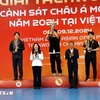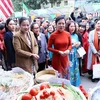“Gia ra” is the biggest festival in a year for the Cor ethnic minority group, who live mainly in the central province of Quang Ngai’s Tay Tra and Tra Bong districts as they mark the end of a rice crop, traditionally lasting one year.
The Gia ra festival, usually taking place from the 10th to the 11th month on the lunar calendar, is important to them just like the Lunar New Year holiday to the Kinh people, the ethnic majority group in Vietnam. It is different from the “com moi”(new rice) ceremony, which marks the start of the harvest time.
After harvesting rice and placing all the rice grains in the storage hut, the village elderly will choose good days for the festival, intended as an occasion for all villagers to show their gratitude to gods who gave them a bumper crop and have some leisure time after hardworking days.
On the day before the festival, the head of the family will wrap some rice grains in wild banana leaves, putting one of these parcels at the rice storage hut and bringing home the other to invite the rice soul to his house.
The family’s head will rub grains in his hands and then put them on each family member’s head to wish for good luck in the coming year. Women in the village gather to make glutinous rice cakes wrapped in “dot” leaves to offer to ancestors and the gods of rivers, streams, mountains, and forests.
At dawn of the first day of the festival, the family’s head will invite gods and ancestors to join his family during the three-day festival. He and his eldest son will sit in front of the altar full of offerings such as rat meat, rice cakes, and alcohol, and say the prayers for three times, namely “Mo Huyt am ba” (Mistress Huyt gives rice), “Mo Rit am ba” (Mistress Rit gives rice), and “Mo Crai am ba” (Mistress Crai gives rice). Then, they will place some cooked glutinous rice grains on family members’ heads in order to keep the rice soul.
The Cor people believe that female gods are busy from early morning like women, so rituals must be done early so that they can begin their workday soon. Meanwhile, rituals worshipping male gods and ancestors are usually done after 8am.
After worshipping male gods, a ritual will be held to move the rice god from the house to the rice storage hut. For this purpose, nine knots will be tied in a white thread resembling a ladder for the rice god to climb to the rice storage hut on the field to watch over the crop.
In the following days, more rituals will be conducted to pay respect to different gods praying for prosperity, good harvest and good animal breeding
The Cor people also believe that the more guests a family receives during the Gia ra festival, the luckier they are in the new year. Therefore, local residents always warmly welcome guests, and people from nearby villages also come to visit and wish one another a happy new year.
During Gia ra, natives also organise folk games such as archery, wrestling, javelin, cake making, and rice pounding, along with singing and dancing performances with traditional musical instruments like Amap, a small panpipe used only by Cor women, and gongs.
In the past, each family took turn to celebrate Gia ra festival, making the festival last for one or even two months in a village. Nowadays, Gia ra has become much simpler and takes place for only three days. It is also a chance to discuss preparations for a new rice crop.-VNA
The Gia ra festival, usually taking place from the 10th to the 11th month on the lunar calendar, is important to them just like the Lunar New Year holiday to the Kinh people, the ethnic majority group in Vietnam. It is different from the “com moi”(new rice) ceremony, which marks the start of the harvest time.
After harvesting rice and placing all the rice grains in the storage hut, the village elderly will choose good days for the festival, intended as an occasion for all villagers to show their gratitude to gods who gave them a bumper crop and have some leisure time after hardworking days.
On the day before the festival, the head of the family will wrap some rice grains in wild banana leaves, putting one of these parcels at the rice storage hut and bringing home the other to invite the rice soul to his house.
The family’s head will rub grains in his hands and then put them on each family member’s head to wish for good luck in the coming year. Women in the village gather to make glutinous rice cakes wrapped in “dot” leaves to offer to ancestors and the gods of rivers, streams, mountains, and forests.
At dawn of the first day of the festival, the family’s head will invite gods and ancestors to join his family during the three-day festival. He and his eldest son will sit in front of the altar full of offerings such as rat meat, rice cakes, and alcohol, and say the prayers for three times, namely “Mo Huyt am ba” (Mistress Huyt gives rice), “Mo Rit am ba” (Mistress Rit gives rice), and “Mo Crai am ba” (Mistress Crai gives rice). Then, they will place some cooked glutinous rice grains on family members’ heads in order to keep the rice soul.
The Cor people believe that female gods are busy from early morning like women, so rituals must be done early so that they can begin their workday soon. Meanwhile, rituals worshipping male gods and ancestors are usually done after 8am.
After worshipping male gods, a ritual will be held to move the rice god from the house to the rice storage hut. For this purpose, nine knots will be tied in a white thread resembling a ladder for the rice god to climb to the rice storage hut on the field to watch over the crop.
In the following days, more rituals will be conducted to pay respect to different gods praying for prosperity, good harvest and good animal breeding
The Cor people also believe that the more guests a family receives during the Gia ra festival, the luckier they are in the new year. Therefore, local residents always warmly welcome guests, and people from nearby villages also come to visit and wish one another a happy new year.
During Gia ra, natives also organise folk games such as archery, wrestling, javelin, cake making, and rice pounding, along with singing and dancing performances with traditional musical instruments like Amap, a small panpipe used only by Cor women, and gongs.
In the past, each family took turn to celebrate Gia ra festival, making the festival last for one or even two months in a village. Nowadays, Gia ra has become much simpler and takes place for only three days. It is also a chance to discuss preparations for a new rice crop.-VNA



















